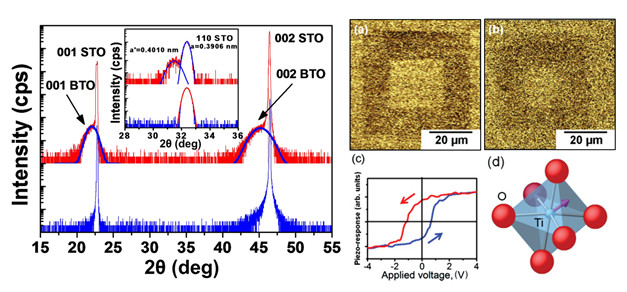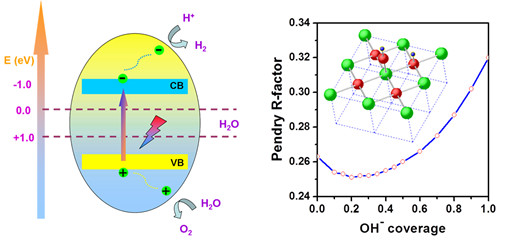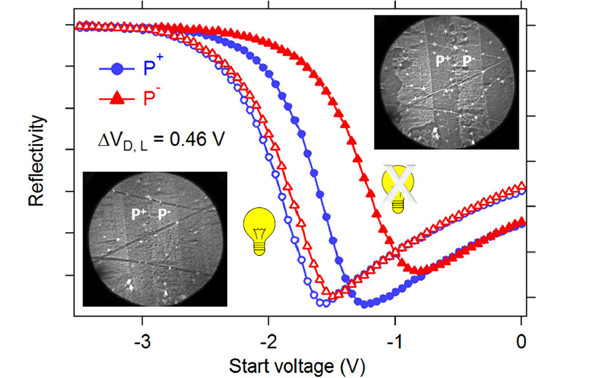« Back to the Group page « Back to the Contracts page
Project overview
Discovery of quasi-amorphous ultra-thin BaTiO3 films
We have identified the ferroelectric phase in a quasiamorphous (QA) ultrathin BaTiO3 (BTO) film. In-plane clamping prevents nucleation of the as-deposited amorphous BTO during annealing in O2 flow and results in the formation of a QA phase. The amorphous nature is confirmed by in- and out-of-plane XRD. FE polarized domains with good retention have been successfully written into the film and the FE nature is proven by a clear P-E hysteresis curve. In the literature, the QA phase was generated from the strain induced by pulling through a high temperature gradient, whereas here the strain state is governed by surface clamping. We demonstrate the preparation of a QA FE BTO thin film grown on SrTiO3 (STO) substrate by uniform post-deposition annealing.For more details see Physical Review B (Phys. Rev. B 84, 205426 (2011)) “editors' suggestion'.

Screening of surface polarization charge by atomic rumpling and relaxation
Secondly, we have studied the atomic and chemical structure of the surface of a fully strained, TiO2-terminated, ferroelectric BaTiO3(001) epitaxial film on a SrTiO3 substrate after controlled exposure to water. Water undergoes mainly dissociative adsorption on the surface. The Ti on-top site is the dominant site for OH– chemisorption. One fifth of the surface Ti atoms bind to OH–. The concentration of surface oxygen vacancies acts mainly to favor initial physisorption. Before exposure to water, the outward pointing polarization in the BTO film is stabilized by atomic rumpling in the TiO2 termination layer. After exposure to water, the chemisorbed OH– species provide the screening, inverting the surface dipole layer and stabilizing the bulk polarization. Molecular adsorption is observed only for high water coverage. This work was published by Journal of Physical Chemistry C (J. Phys. Chem. C 116 21802 (2012)).

Screening of polarization by photo-generated charge
the surface potential contrast between oppositely polarized ferroelectric domains of a BaTiO3 (001) single crystal under ultraviolet (UV) illumination before and after the dissociative adsorption of water is measured using the transition from mirror electron microscopy to low-energy electron microscopy. Both photo-generated free charge carriers and dissociative adsorption of water are effective screening mechanisms of the surface polarization charge. The screening rate is dominated by drift, whereas the relaxation in the absence of UV light is driven by thermal diffusion. Surface chemistry plays an important role in the surface charge dynamics. This work has been published by Applied physics letter (Appl. Phys. Lett. 101 092902 (2012)).

Information
Funding
- Project ANR Blanc SIMI 10 (2010) (Project page on ANR website)
Coordination
Partners
- SPMS – ECP CNRS — DR Île-de-France Secteur Ouest et Nord
- INL CNRS — DR Rhône-Auvergne
- IRCELYON — Université Claude Bernard, Lyon I
Specifications
- Funding amount: 821 643 euros
- Project duration: 36 mois
- Starting date: Octobre 2010




